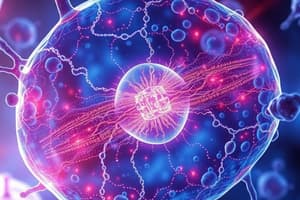Podcast
Questions and Answers
What forms the cell's outer boundary?
What forms the cell's outer boundary?
- Cytoplasm
- Plasma membrane (correct)
- Cytoskeleton
- Nucleus
The nucleus contains RNA.
The nucleus contains RNA.
False (B)
What is the role of the cytoskeleton?
What is the role of the cytoskeleton?
Provides structural support for the cell
The _____ is the site of many chemical reactions within the cell.
The _____ is the site of many chemical reactions within the cell.
Which of the following organelles is responsible for protein synthesis?
Which of the following organelles is responsible for protein synthesis?
What are the two types of endoplasmic reticulum?
What are the two types of endoplasmic reticulum?
What do cilia do?
What do cilia do?
Centrosomes consist of two _____ and pericentriolar material.
Centrosomes consist of two _____ and pericentriolar material.
Study Notes
The Cellular Level of Organization
- Plasma membrane: Serves as the cell's outer boundary, isolating the internal environment from the external. Functions as a selective barrier and is essential for cellular communication.
- Cytoplasm: Comprises all contents between the plasma membrane and nucleus, consisting of cytosol (the fluid portion) and organelles (specialized structures within the cell).
- Nucleus: A large organelle that houses DNA, contains chromosomes (composed of DNA and proteins), and thousands of hereditary units known as genes.
Components of Cytoplasm
-
Cytosol:
- Intracellular fluid surrounding organelles.
- Site for numerous chemical reactions that release energy.
- Provides building blocks necessary for cell maintenance, structure, function, and growth.
-
Organelles:
- Distinct structures with specific functions.
- Cytoskeleton:
- Network of protein filaments within the cytosol, offering structural support.
- Comprised of three types: microfilaments, intermediate filaments, and microtubules, arranged by increasing size.
Key Organelles
-
Centrosome:
- Located near the nucleus, consists of two centrioles and pericentriolar material.
-
Cilia:
- Short hair-like projections that facilitate the movement of fluids along the cell surface.
-
Flagella:
- Longer than cilia, enabling the movement of an entire cell (e.g., sperm cell's tail).
-
Ribosomes:
- Sites of protein synthesis located either freely in the cytosol or attached to the endoplasmic reticulum.
Endoplasmic Reticulum (ER)
-
Network of membranes configured as flattened sacs or tubules.
-
Rough ER:
- Connected to the nuclear envelope and studded with ribosomes.
- Functions in the production of various proteins.
-
Smooth ER:
- Composed of membrane tubules without ribosomes.
- Synthesizes fatty acids and steroids and detoxifies drugs.
Studying That Suits You
Use AI to generate personalized quizzes and flashcards to suit your learning preferences.
Related Documents
Description
Explore the fundamental concepts of cellular organization in this quiz based on Chapter 3 of your biology textbook. Questions will cover components like the plasma membrane and its functions, as well as the generalized structure of cells. Test your understanding of how cells maintain their internal environment and communicate with the outside world.




